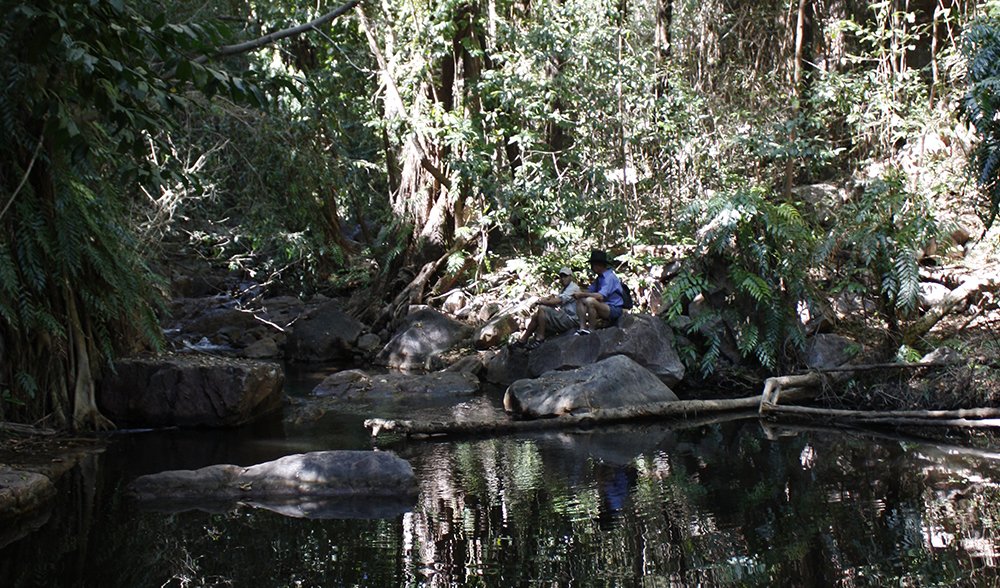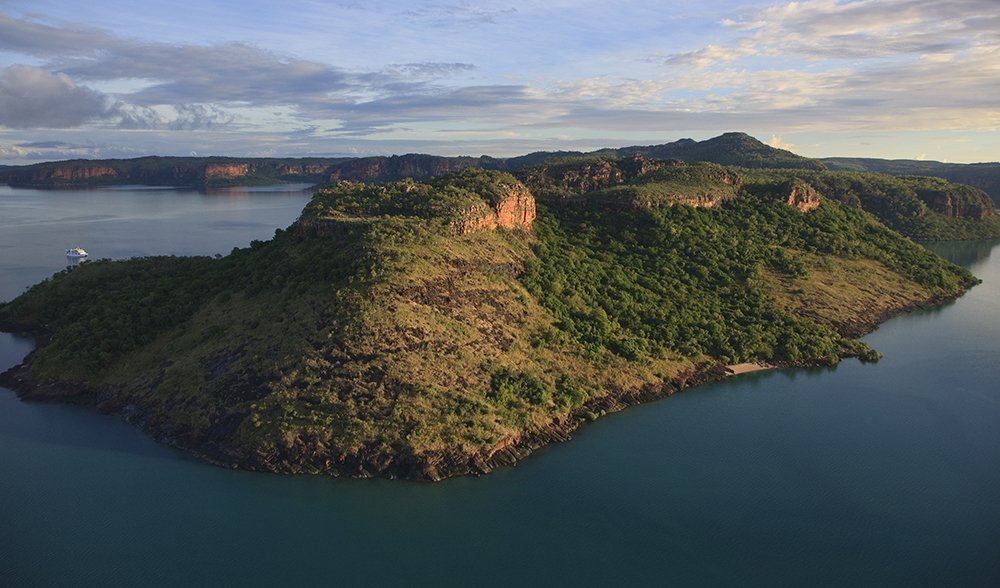Mike Cusack’s thirty years of the wilderness

“A YEAR IN THE wilderness: imagine spending a year in splendid isolation in a place like this magnificent stretch of Kimberley coast. We’re looking for an adventurous couple who will accept such a challenge.”
This attention-grabbing line was hard to resist. The ad on page 27 of AG#4 (Oct–Dec 1986) was accompanied by an enticing image of turquoise waters, whitesand beach, and the rugged ochre sea cliffs of the Kimberley.
I now recognise this as Tranquil Bay, 3.5km north-west of the mouth of the King George River on the northern Kimberley coast. At Dick Smith’s direction, Australian Geographic was “looking for a couple who would like to have the experience of their lives by spending a year virtually isolated, in one of Australia’s wild places”.

Mike Cusack at Laceepe Islands. (Photo credit: Quentin Chester)
Five hundred couples from Australia and overseas responded, but fate smiled upon me and my wife, Susan. We were chosen as the successful couple, and by 28 June 1987 we were on site amid the forlorn ruins of the former Presbyterian mission at Kunmunya, inland of Port George IV. The year that unfolded left an indelible mark upon us. For me it was the catalyst for what has become my cherished part-time career; since 1998 I have led expedition cruises along the Kimberley coast for Aurora Expeditions.
The 12 months at Kunmunya was a mixed bag of fortunes. We endured the driest year in three decades. Drinking water became a scarcity at the end of the Dry, with seemingly little prospect of the Wet replenishing things. For the scant fresh water we competed with not only the native wildlife, but also scores of feral donkeys that roamed the Kimberley. Fortunately for the welfare of the environment, the donkeys have all been removed.
We constructed a ‘house’ of sorts from Darwin woollybutt and bloodwood. We first intended it to be roofed with paperbark, but we were able to salvage enough sheets of corrugated iron from the former mission site to just cover it. It was basic, with two rooms of an equal 4 x 4m size. We aligned it east–west, with our combined bedroom-library-dining room facing the morning sun.
This section was built off the ground for several reasons. Bits of vegetation caught in branches of creek-side melaleucas showed that high flood levels could be expected, possibly as a consequence of a cyclone. Being up high gave some prospect of air circulation – that was the theory, anyway. Our earlier nights spent camped on the ground were often uncomfortable as the day’s heat was released from the ground through the night.
It took almost seven months to complete this simple dwelling.
There were days at a time when nothing was done on the construction as we struggled with dehydration. The bushfire that passed across us in late September also diverted our focus. There were days of debilitating heat and humidity, and we had an average daily temperature of 45°C for almost three months. Then there were days of cool subtlety in the ‘cold’ month of July, when mist would linger in the early morning, cloaking the jagged pandanus and bulbous boabs in a surreal silhouette.

The Kimberely’s Horizontal Falls. (Photo credit: Quentin Chester)
Today, though, the memories of harsh days in blistering sun have been replaced by the wonder of the whole experience. The apparent disregard for us by the natural world remains strongly imprinted. Most animals became oblivious to our presence and went about their daily activities unaffected. If we did make an impression, it was because we were a serendipitous source of food.
Not us personally – although we suffered a few bites. ‘Ta-ta’ lizards (Gilbert’s dragons) had a Pavlovian response to my chain-sawing because it invariably exposed a feast of termites. Their antics made them our resident comedians.
Living in such intimate connection with the natural world was simultaneously a humbling and empowering experience. Our utter insignificance as two humans in that great wilderness gave us a sense of humility. There was serenity in those moments where we sat in silence with the rhythm of nature playing out around us and with the knowledge that Worora people, on whose country we were camped, had survived here for more than 400 generations. The experience was empowering because we grew in overcoming significant challenges, both psychological and physical.

Water hole hike in the Kimberley. (Photo credit: Mael Ressos)
The Kimberley is one of the world’s last great wildernesses. This ancient landscape has a quiet potency and sublime, beguiling beauty. Haunting paintings from long-gone artists adorn rock shelters and it’s easy to be overcome with awe and reverence in the presence of these, much as the Aboriginal inhabitants must have been.
The pull of the Kimberley hasn’t diminished over these past 30 years. Admittedly, since the first tour boat appeared in mid- 1988, there has been a significant increase in tourism. There are now at least 16 commercial vessels plying the route between Broome and Wyndham or Darwin. Nonetheless, it remains the “longest, undefiled coastline in the world”, as once described in the AG book The Kimberley: Horizons of Stone. Experience the Kimberley for yourself and immerse yourself in its ancient majesty.
It will be salve to your soul.
Join Mike Cusack on the Kimberley coast in 2017!
In 2017, Aurora Expeditions and the AG Society will celebrate the 30th anniversary of Australian Geographic’s first ‘Wilderness Couple’ with four Kimberley Coast expeditions led by Mike. Find out more and book.

The Coral Expeditions I from above in the Kimberley. (Photo credit: Andrew Halsall)




